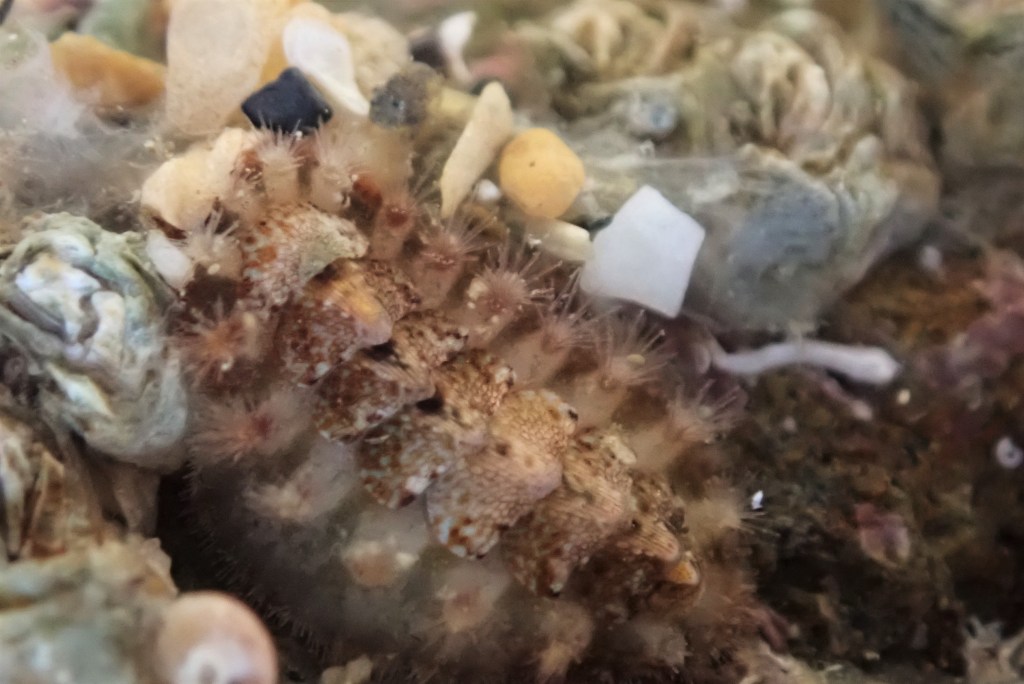As you may have noticed, blog writing has been relegated to my ‘to do dreckly’ list for a couple of months now. In September, I unexpectedly started a job that I didn’t know I’d applied for and my photos of rock pooling trips, including this day at Prisk Cove, have been piling up ever since. It’s time for a catch-up!
A swimming variegated scallop was one of the highlights of this short video I put together at Prisk Cove this autumn.
For once, the gales and mizzle held off for our visit to Prisk Cove, making it an ideal day for sitting by the pools and staring. The longer I looked the more I discovered.
This Aeolidiella alderi sea slug had recently munched its way through a Daisy anemone, turning the cerata on its back from white to a deep, speckled brown. It is sometimes called the ‘white-ruffed’ slug due to the paler cerata that form a smart collar behind its head.
Finding a nudibranch sea slug made an auspicious start to the day, and there were plenty more discoveries in store. Many of the tunicate sea squirts I find on the shore are dull brown, but this Ascidia mentula was an explosion of colour.
Nearby, a chiton nestled among the barnacles, moving very slightly as I watched. These unassuming little molluscs have changed very little since the Devonian period. You have to look closely to appreciate their varied patterns. There are several species commonly found on our shores and some – like this one – have clusters of bristles fringing their armoured plates.
Flatworms are far more exciting to watch than chitons. They are speedy for their size, flowing seamlessly over rock and engulfing any obstacles they meet.
This remarkably bright flatworm is a Cycloporus papillosus. I mostly see them in shades of star-studded blue, but this one has other ideas. They vary in colour to match their equally resplendent prey, the star ascidian sea squirt.
Caught crossing the rock in search of new food supplies, this flatworm was easy to spot. Once it is on a sea squirt, it will become almost invisible.
Rocky overhangs are my happy place. They’re a kind of lucky dip with fascinating creatures hiding in every single one. I wouldn’t advise putting a hand in an overhang as there’s almost always a crab lurking at the back, but it’s worth going through the contortions required to obtain a good view of what lies within. This spiny starfish, however, wouldn’t win any games of hide-and-seek.

Unlike the starfish, my next find was a master of disguise, hugging the rock and changing colour to match it. Only the googly eyes and a tiny fluttering fin gave this topknot flatfish away.
Among boulders encrusted in colourful sponges, I was delighted to find my favourite slug: “Discodoris” – the Geitodoris planata. This one was busy tucking into the sponges and sported plenty of acid glands to ward off any would-be predators, visible as white patches on the slug’s back.
Tortoiseshell limpets can go unnoticed due to their diminutive size, but they have one of the prettiest shells on our shores. This one, nestling among the pink seaweeds, was a perfect burst of pink and blue.
I always tell people that they should go slowly and look closely to see and appreciate wildlife. It works every time and is good advice for life in general, yet it’s advice I sometimes forget myself. In my haste to find the next thing, I can easily miss what is in front of me.
This quiet, meandering day at Prisk Cove, was a rare chance to truly stop and look, to watch animals doing their own thing. From the mysid prawns flocking around the snakelocks anemones to the way the green shore urchins had arranged their shelters of seaweed, pebbles and shells, there were endless insights into rockpool life. If the tide hadn’t come in, I would happily have stayed for many hours, staring into those perfect pools.
Nadelik lowen! Merry Christmas! Wishing you a happy and restful time.
Whatever the weather, always stay safe in the rock pools. Follow my rockpooling tips to look after yourself and the wildlife on the shore.
This website is a labour of much love and the content is available for free to everyone. My wonderful readers often ask if there is a way to support my work. You can now ‘buy me a coffee’ through my Ko-fi.uk page. (Just click donate and you can set the amount to pay by PayPal). Thank you!

















As always a delight to read, Heather..Thank you.
Wishing you and family and friends many happy hours on the beach in 2022 ….Mavis
LikeLiked by 1 person
Thank you Mavis! Merry Christmas to you and your family too. Fingers crossed for 2022 – I’m looking forward to getting back to more group events if things allow. 🙂
LikeLike
What a wonderful array of marine life – thank you, as ever, for sharing. Covid-willing, I’m down for surveys in January & February. I’ll get in touch. X
LikeLiked by 1 person
Thank you Charlotte! Fingers crossed for your visit. That would be fantastic. x
LikeLike
I just love the inspiring pictures and your style of writing – something so positive to look forward to!
I hope the group events will be beginning again soon.
Happy new year!
LikeLiked by 1 person
Thank you so much, Clarissa. I’m keeping everything crossed that we’ll be able to return to group events in 2022. Nurturing a love of the natural world is so important if we’re going to stand any chance of protecting and restoring wildlife.
LikeLike